Augmented reality (AR) is no longer a concept confined to science fiction; it has become a transformative technology that is reshaping industries across the globe. By merging the physical world with digital content, AR enhances user experiences, boosts productivity, and opens up new avenues for innovation. This article delves into the world of augmented reality services, exploring their applications, benefits, and the future of AR development.
Understanding Augmented Reality
Augmented reality refers to the technology that overlays digital information—such as images, sounds, and videos—onto the real world. Unlike virtual reality, which immerses users in a completely virtual environment, AR enriches the real world by enhancing it with digital elements. This is achieved through various devices, including smartphones, tablets, and AR glasses.
How Augmented Reality Works
At its core, AR relies on a combination of hardware and software technologies. The key components include:
- Sensors: Devices equipped with cameras and sensors gather data about the user’s environment. This includes depth sensing, motion tracking, and GPS data.
- Software: AR applications use sophisticated algorithms to analyze sensor data and overlay relevant digital content onto the physical world in real-time.
- Display: The merged digital and physical environments are presented to users through screens, whether on mobile devices or AR glasses.
Applications of Augmented Reality Services
Augmented reality services span a wide range of industries, offering innovative solutions that enhance user engagement and improve operational efficiency. Here are some notable applications:
1. Retail and E-commerce
AR is revolutionizing the retail sector by providing immersive shopping experiences. Customers can visualize products in their own environment before making a purchase. For instance, furniture retailers like IKEA use AR apps that allow users to see how a piece of furniture will look in their home, helping them make informed decisions. This not only increases customer satisfaction but also reduces return rates.
2. Education and Training
In the educational field, AR enhances learning by making complex concepts more accessible. Medical students, for example, can use AR to visualize human anatomy in 3D, enabling them to interact with lifelike models. Similarly, training programs in various industries utilize AR to simulate real-world scenarios, providing hands-on experience without the associated risks.
3. Healthcare
AR services in healthcare are transforming patient care and surgical procedures. Surgeons can use AR to overlay critical information, such as patient scans, directly onto their field of view during operations. This technology increases precision and minimizes errors, ultimately improving patient outcomes.
4. Gaming and Entertainment
The gaming industry has seen some of the most significant advancements in AR technology. Games like Pokémon GO have popularized AR by blending virtual characters with real-world environments, encouraging players to explore their surroundings. This trend is not limited to gaming; it extends to live events and experiences, creating immersive entertainment options for audiences.
5. Tourism and Navigation
AR is enhancing travel experiences by providing tourists with real-time information about their surroundings. AR apps can offer guided tours, historical context, and local insights simply by pointing a device at a landmark. This interactive approach to tourism enriches the travel experience and helps users connect with their destinations on a deeper level.
6. Real Estate
In real estate, AR services allow potential buyers to visualize properties without physically visiting them. Virtual tours that incorporate AR elements enable clients to see properties in their current state or with potential renovations, streamlining the buying process and making it more efficient.
Benefits of Augmented Reality Services
The adoption of augmented reality services offers several advantages across various sectors:
1. Enhanced Customer Engagement
AR creates immersive experiences that engage users on a deeper level. This interactive approach fosters a stronger emotional connection with brands, ultimately driving customer loyalty and repeat business.
2. Increased Efficiency
In industries like manufacturing and logistics, AR can streamline processes by providing real-time data and instructions directly to workers. This minimizes errors and reduces training time, resulting in improved operational efficiency.
3. Cost-Effectiveness
While the initial investment in AR technology may be significant, the long-term benefits often outweigh the costs. AR can help businesses reduce overhead by minimizing returns in retail, cutting training costs, and increasing productivity.
4. Competitive Advantage
In a rapidly evolving digital landscape, businesses that adopt AR technologies can differentiate themselves from competitors. By offering innovative solutions and enhanced customer experiences, companies can position themselves as industry leaders.
The Future of Augmented Reality Development
The future of augmented reality services looks promising, driven by advancements in technology and increasing consumer demand. Here are some trends to watch:
1. Integration with Artificial Intelligence
As AR technology continues to evolve, its integration with artificial intelligence (AI) will enhance user experiences. AI can analyze user behavior, preferences, and environmental factors to deliver personalized AR content, making experiences more relevant and engaging.
2. 5G Connectivity
The rollout of 5G networks will significantly enhance AR experiences by providing faster data transfer rates and lower latency. This will enable more complex AR applications and real-time interactions, further blurring the lines between the digital and physical worlds.
3. Wearable Technology
AR glasses and other wearable devices are becoming more sophisticated and accessible. As these technologies advance, users will be able to enjoy seamless AR experiences without relying solely on smartphones or tablets.
4. Greater Adoption Across Industries
As more businesses recognize the benefits of AR, its adoption will expand beyond early adopters. Industries such as agriculture, construction, and automotive will increasingly leverage AR services to enhance operations and improve outcomes.
Conclusion
Augmented reality services are poised to transform the way we interact with the world around us. By blending digital content with the physical environment, AR enhances user experiences, boosts efficiency, and drives innovation across various industries. As technology continues to advance, the potential applications of AR will only expand, offering exciting opportunities for businesses and consumers alike. Embracing augmented reality today means investing in the future, where the boundaries between the digital and physical worlds will continue to blur, creating an increasingly interactive and engaging environment for all.



More Stories
Dental CRM: Building Strong, Lasting Patient Relationships.
PVD-Coated vs. Traditional Furniture: Who win?
PCD Pharma Franchise Company in Baddi: Oasis Bio Bloom